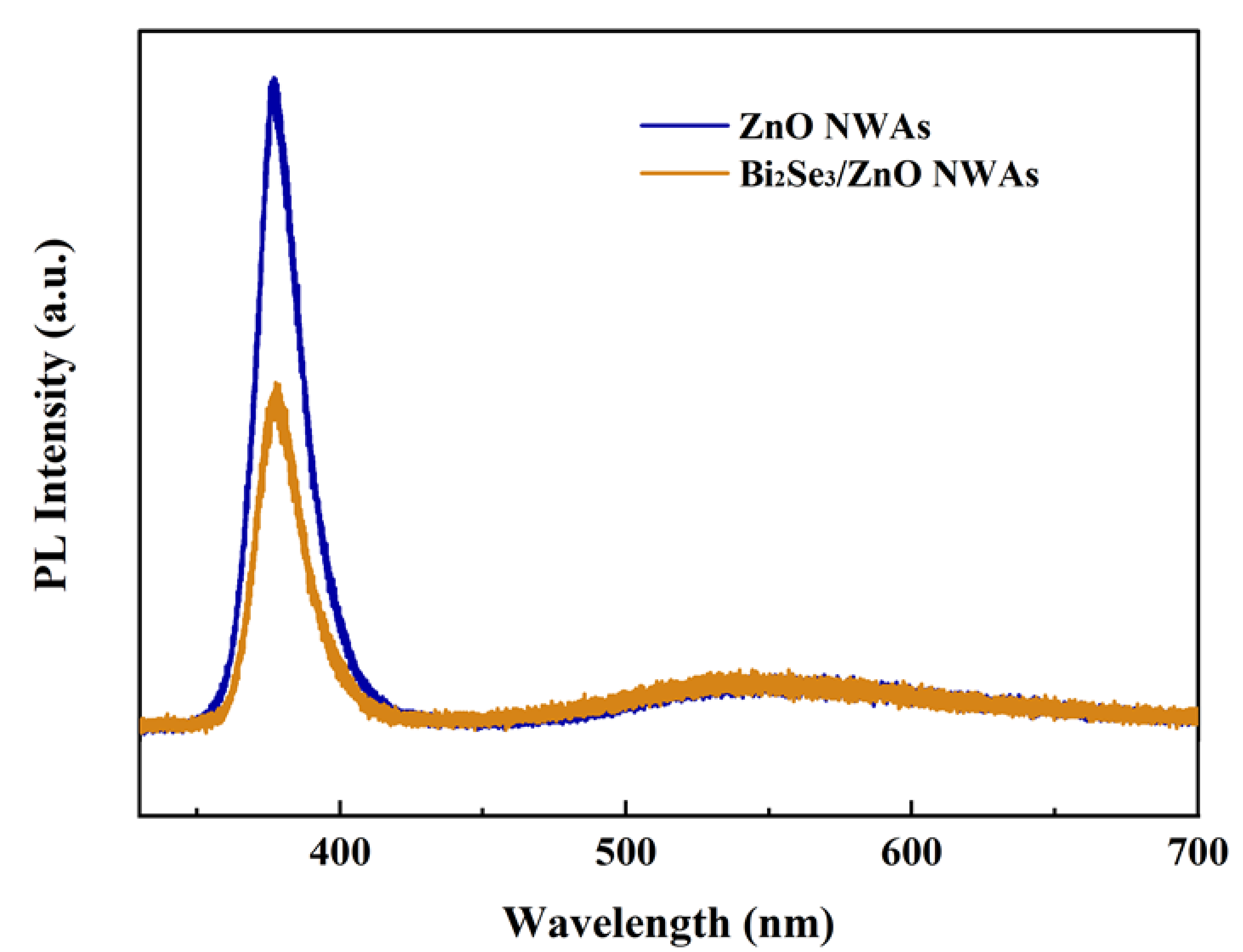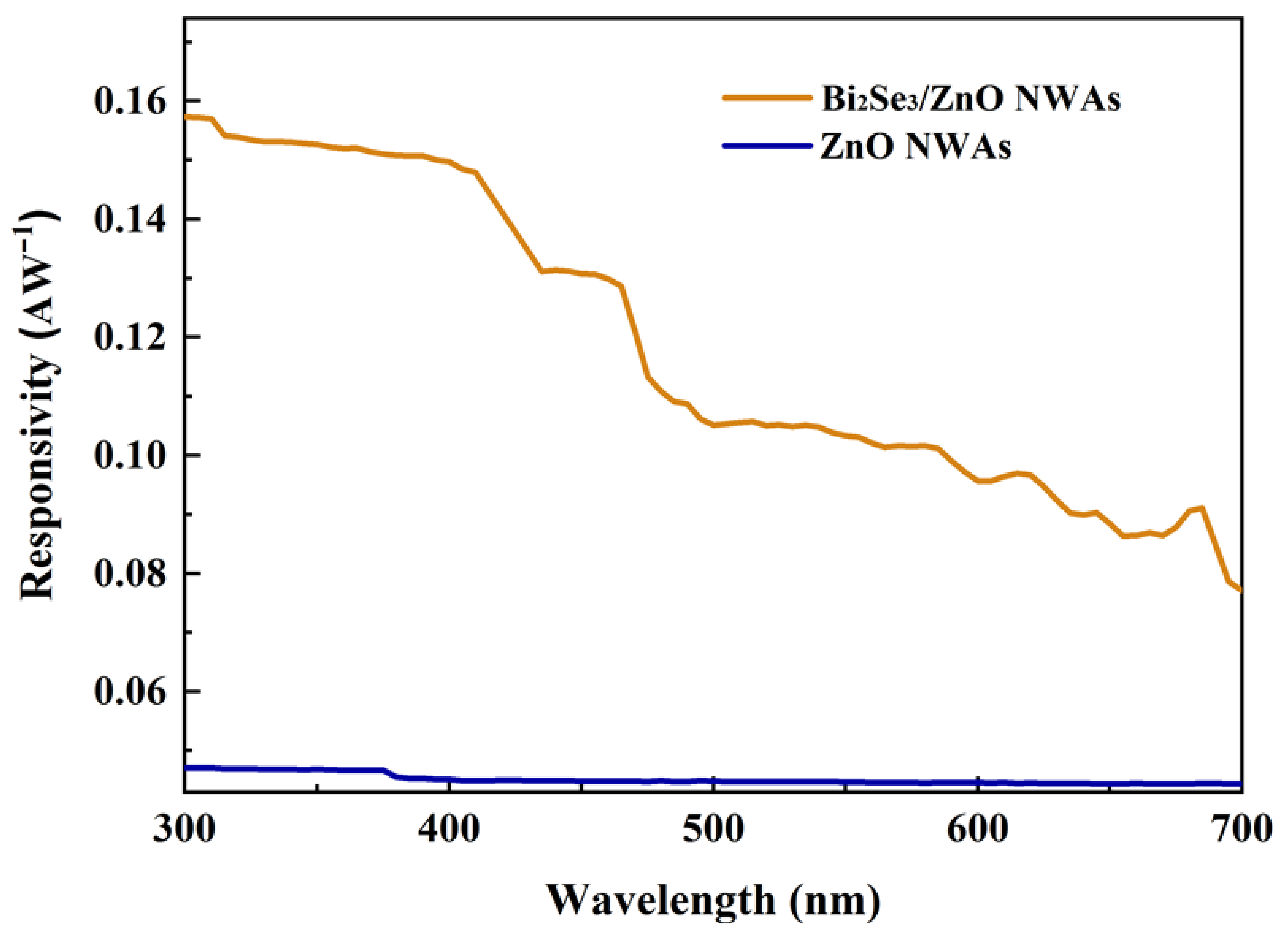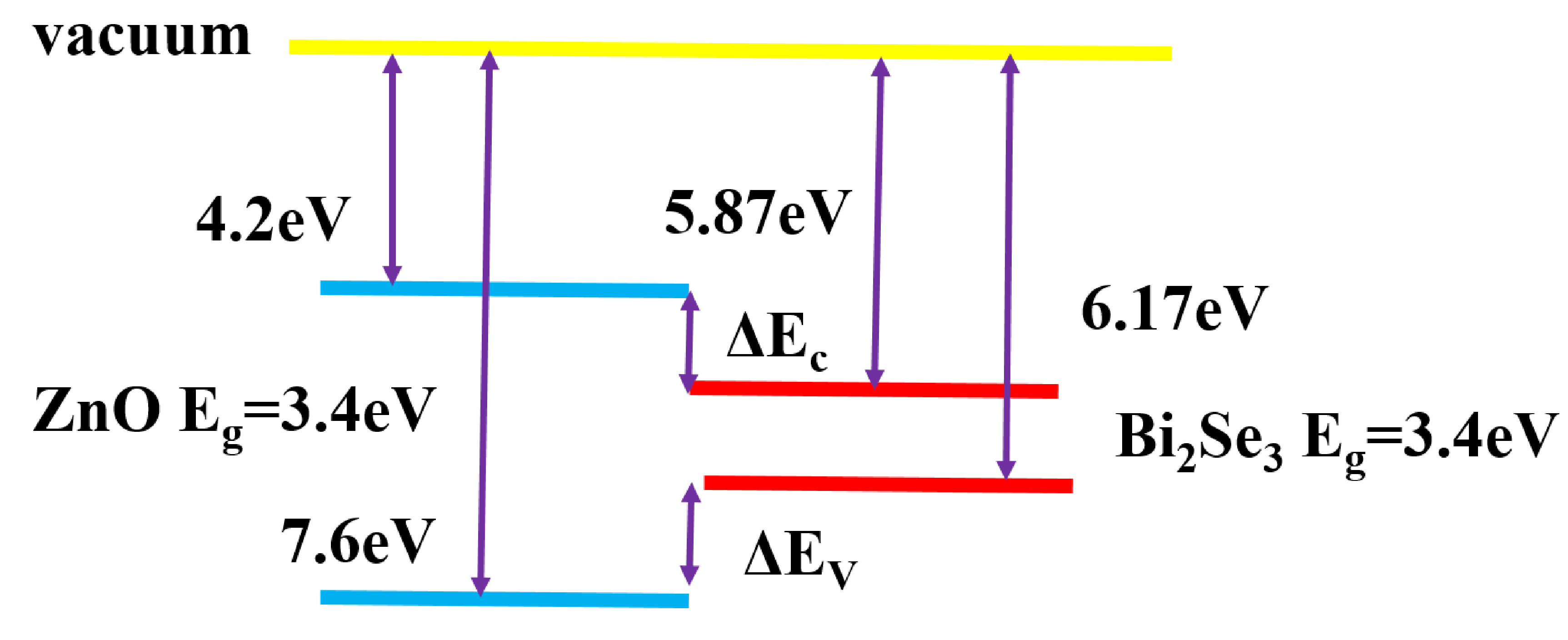Broadband Detection Based on 2D Bi2Se3/ZnO Nanowire Heterojunction
Abstract
1. Introduction
2. Materials and Methods
2.1. Syntheses of ZnO NWAs
2.2. Syntheses of 2D Bi2Se3
2.3. The Transfer of 2D Bi2Se3
2.4. Characterization
3. Results
4. Conclusions
Supplementary Materials
Author Contributions
Funding
Informed Consent Statement
Data Availability Statement
Conflicts of Interest
References
- Bartels, R.A.; Paul, A.; Green, H.; Kapteyn, H.C.; Murnane, M.M.; Backus, S.; Christov, I.P.; Liu, Y.; Attwood, D.; Jacobsen, C. Generation of spatially coherent light at extreme ultraviolet wavelengths. Science 2002, 297, 376–378. [Google Scholar] [CrossRef]
- Huo, N.J.; Konstantatos, G. Recent progress and future prospects of 2d-based photodetectors. Adv. Mater. 2018, 30, 1801164. [Google Scholar] [CrossRef]
- Pospischil, A.; Humer, M.; Furchi, M.M.; Bachmann, D.; Guider, R.; Fromherz, T.; Mueller, T. CMOS-compatible graphene photodetector covering all optical communication bands. Nat. Photonic. 2013, 7, 892–896. [Google Scholar] [CrossRef]
- Formisano, V.; Atreya, S.; Encrenaz, T.; Ignatiev, N.; Giuranna, M. Detection of methane in the atmosphere of Mars. Science 2004, 306, 1758–1761. [Google Scholar] [CrossRef]
- Liu, W.B.; Zhang, J.F.; Zhu, Z.H.; Yuan, X.D.; Qin, S.Q. Electrically tunable absorption enhancement with spectral and polarization selectivity through graphene plasmonic light trapping. Nanomaterials 2016, 6, 155. [Google Scholar] [CrossRef] [PubMed]
- Li, Y.F.; Zhang, Y.T.; Li, T.T.; Li, M.Y.; Chen, Z.L.; Li, Q.Y.; Zhao, H.L.; Sheng, Q.; Shi, W.; Yao, J. Ultrabroadband, ultraviolet to terahertz, and high sensitivity CH3NH3PbI3 perovskite photodetectors. Nano Lett. 2020, 20, 5646–5654. [Google Scholar] [CrossRef]
- Aldalbahi, A.; Velazquez, R.; Zhou, A.F.; Rahaman, M.; Feng, P.X. Bandgap-tuned 2d boron nitride/tungsten nitride nanocomposites for development of high-performance deep ultraviolet selective photodetectors. Nanomaterials 2020, 10, 1433. [Google Scholar] [CrossRef] [PubMed]
- Ni, S.M.; Guo, F.Y.; Wang, D.B.; Liu, G.; Xu, Z.K.; Kong, L.P.; Wang, J.Z.; Jiao, S.J.; Zhang, Y.; Yu, Q.J.; et al. Effect of MgO surface modification on the TiO2 nanowires electrode for self-powered UV photodetectors. ACS Sustain. Chem. Eng. 2018, 6, 7265–7272. [Google Scholar] [CrossRef]
- Liang, S.; Sheng, H.; Liu, Y.; Huo, Z.; Lu, Y.; Shen, H. ZnO Schottky ultraviolet photodetectors. J. Cryst. Growth 2001, 225, 110–113. [Google Scholar] [CrossRef]
- Jiao, S.J.; Zhang, Z.Z.; Lu, Y.M.; Shen, D.Z.; Yao, B.; Zhang, J.Y.; Li, B.H.; Zhao, D.X.; Fan, X.W.; Tang, Z.K. ZnO p-n junction light-emitting diodes fabricated on sapphire substrates. Appl. Phys. Lett. 2006, 88, 031911. [Google Scholar] [CrossRef]
- Monroy, E.; Omnes, F.; Calle, F. Wide-bandgap semiconductor ultraviolet photodetectors. Semicond. Sci. Technol. 2003, 18, R33–R51. [Google Scholar] [CrossRef]
- Jin, Y.Z.; Wang, J.P.; Sun, B.Q.; Blakesley, J.C.; Greenham, N.C. Solution-processed ultraviolet photodetedtors based on colloidal ZnO nanoparticles. Nano Lett. 2008, 8, 1649–1653. [Google Scholar] [CrossRef]
- Gedamu, D.; Paulowicz, I.; Kaps, S.; Lupan, O.; Wille, S.; Haidarschin, G.; Mishra, Y.K.; Adelung, R. Rapid fabrication technique for interpenetrated ZnO nanotetrapod networks for Fast UV sensors. Adv. Mater. 2014, 26, 1541–1550. [Google Scholar] [CrossRef] [PubMed]
- Hu, L.F.; Yan, J.; Liao, M.Y.; Xiang, H.J.; Gong, X.G.; Zhang, L.D.; Fang, X.S. An optimized ultraviolet-a light photodetector with wide-range photoresponse based on ZnS/ZnO biaxial nanobelt. Adv. Mater. 2012, 24, 2305–2309. [Google Scholar] [CrossRef]
- Zhang, B.K.; Li, Q.; Wang, D.B.; Wang, J.Z.; Jiang, B.J.; Jiao, S.J.; Liu, D.H.; Zeng, Z.; Zhao, C.C.; Liu, Y.X.; et al. Efficient photocatalytic hydrogen evolution over TiO2–X mesoporous spheres-ZnO nanowires heterojunction. Nanomaterials 2020, 10, 2096. [Google Scholar] [CrossRef]
- Liu, X.; Gu, L.L.; Zhang, Q.P.; Wu, J.Y.; Long, Y.Z.; Fan, Z.Y. All-printable band-edge modulated ZnO nanowire photodetectors with ultra-high detectivity. Nat. Commun. 2014, 5, 1–9. [Google Scholar] [CrossRef] [PubMed]
- Kim, H.; Yan, H.Q.; Messer, B.; Law, M.; Yang, P.D. Nanowire ultraviolet photodetectors and optical switches. Adv. Mater. 2002, 14, 158–160. [Google Scholar]
- Yang, J.L.; Liu, K.W.; Shen, D.Z. Recent progress of ZnMgO ultraviolet photodetector. Chin. Phys. B 2017, 26, 047308. [Google Scholar] [CrossRef]
- Gu, P.; Zhu, X.H.; Yang, D.Y. Vertically aligned ZnO nanorods arrays grown by chemical bath deposition for ultraviolet photodetectors with high response performance. J. Alloys Compd. 2020, 815, 152346. [Google Scholar] [CrossRef]
- Park, Y.H.; Shin, H.; Noh, S.J.; Kim, Y.; Lee, S.S.; Kim, C.G.; An, K.S.; Park, C.Y. Optical quenching of NiO/Ni coated ZnO nanowires. Appl. Phys. Lett. 2007, 91, 012102. [Google Scholar] [CrossRef]
- Liu, S.; Liao, Q.L.; Zhang, Z.; Zhang, X.K.; Lu, S.N.; Zhou, L.X.; Hong, M.Y.; Kang, Z.; Zhang, Y. Strain modulation on graphene/ZnO nanowire mixed dimensional van der Waals heterostructure for high-performance photosensor. Nano Res. 2017, 10, 3476–3485. [Google Scholar] [CrossRef]
- Li, C.L.; Han, C.; Zhang, Y.B.; Zang, Z.G.; Wang, M.; Tang, X.S.; Du, J.H. Enhanced photoresponse of self-powered perovskite photodetector based on ZnO nanoparticles decorated CsPbBr3 films. Sol. Energ. Mat. Sol. Cells 2017, 172, 341–346. [Google Scholar] [CrossRef]
- Patel, M.; Pataniya, P.M.; Patel, V.; Sumesh, C.K.; Late, D.J. Large area, broadband and highly sensitive photodetector based on ZnO-WS2/Si heterojunction. Sol. Energy 2020, 206, 974–982. [Google Scholar] [CrossRef]
- Hsiao, Y.J.; Fang, T.H.; Ji, L.W.; Yang, B.Y. Red-shift effect and sensitive responsivity of MoS2/ZnO flexible photodetectors. Nanoscale Res. Lett. 2015, 10, 443. [Google Scholar] [CrossRef][Green Version]
- Oh, I.K.; Kim, W.H.; Zeng, L.; Singh, J.; Bae, D.; Mackus, A.J.M.; Song, J.G.; Seo, S.; Shong, B.; Kim, H.; et al. Synthesis of a hybrid nanostructure of ZnO-decorated MoS2 by atomic layer deposition. ACS Nano 2020, 14, 1757–1769. [Google Scholar] [CrossRef] [PubMed]
- Lan, C.Y.; Li, C.; Wang, S.; Yin, Y.; Guo, H.Y.; Liu, N.S.; Liu, Y. ZnO-WS2 heterostructures for enhanced ultra-violet photodetectors. RSC Adv. 2016, 6, 67520–67524. [Google Scholar] [CrossRef]
- Lv, W.Q.; Liu, J.; He, Y.; You, J.H. Atomic layer deposition of ZnO thin film on surface modified monolayer MoS2 with enhanced photoresponse. Ceram. Int. 2018, 44, 23310–23314. [Google Scholar] [CrossRef]
- Ma, J.C.; Deng, K.; Zheng, L.; Wu, S.F.; Liu, Z.; Zhou, S.Y.; Sun, D. Experimental progress on layered topological semimetals. 2D Mater. 2019, 6, 032001. [Google Scholar] [CrossRef]
- Lai, J.W.; Liu, X.; Ma, J.C.; Wang, Q.S.; Zhang, K.N.; Ren, X.; Liu, Y.N.; Gu, Q.Q.; Zhuo, X.; Lu, W.; et al. Anisotropic broadband photoresponse of layered Type-II weyl semimetal MoTe2. Adv. Mater. 2018, 30, 1707152. [Google Scholar] [CrossRef] [PubMed]
- Zeng, Z.; Wang, D.B.; Wang, J.Z.; Jiao, S.J.; Huang, Y.W.; Zhao, S.X.; Zhang, B.K.; Ma, M.Y.; Gao, S.Y.; Feng, X.; et al. Self-assembly synthesis of the MoS2/PtCo alloy counter electrodes for high-efficiency and stable low-cost dye-sensitized solar cells. Nanomaterials 2020, 10, 1725. [Google Scholar] [CrossRef] [PubMed]
- Zeng, L.H.; Lin, S.H.; Li, Z.J.; Zhang, Z.X.; Zhang, T.F.; Xie, C.; Mak, C.H.; Chai, Y.; Lau, S.P.; Luo, L.B.; et al. Driven, air-stable, and broadband photodetector based on vertically aligned PtSe2/GaAs heterojunction. Adv. Funct. Mater. 2018, 28, 1705970. [Google Scholar] [CrossRef]
- Lee, Y.F.; Punugupati, S.; Wu, F.; Jin, Z.; Narayan, J.; Schwartz, J. Evidence for topological surface states in epitaxial Bi2Se3 thin film grown by pulsed laser deposition through magneto-transport measurements. Curr. Opin. Solid State Mater. Sci. 2014, 18, 279–285. [Google Scholar] [CrossRef]
- Yu, X.C.; Yu, P.; Wu, D.; Singh, B.; Zeng, Q.S.; Lin, H.; Zhou, W.; Lin, J.H.; Suenaga, K.; Liu, Z.; et al. Atomically thin noble metal dichalcogenide: A broadband mid-infrared semiconductor. Nat. Commun. 2018, 9, 1–9. [Google Scholar] [CrossRef]
- Yin, J.B.; Tan, Z.J.; Hong, H.; Wu, J.X.; Yuan, H.T.; Liu, Y.J.; Chen, C.; Tan, C.W.; Yao, F.R.; Li, T.R.; et al. Ultrafast and highly sensitive infrared photodetectors based on two-dimensional oxyselenide crystals. Nat. Commun. 2018, 9, 3311. [Google Scholar] [CrossRef] [PubMed]
- Wang, D.B.; Jiao, S.J.; Sun, S.J.; Zhao, L.C. Al0 40 in 0.02Ga0.58N Based Metal-semiconductor-metal Photodiodes for Ultraviolet Detection. In Proceedings of the 2012 International Conference on Optoelectronics and Microelectronics, Changchun, China, 23–25 August 2012. [Google Scholar]
- Zhang, X.; Zhu, T.S.; Huang, J.W.; Wang, Q.; Cong, X.; Bi, X.Y.; Tang, M.; Zhang, C.R.; Zhou, L.; Zhang, D.Q.; et al. Electric field tuning of interlayer coupling in noncentrosymmetric 3R-MoS2 with an electric double layer interface. ACS Appl. Mater. Interfaces 2020, 12, 46900–46907. [Google Scholar] [CrossRef] [PubMed]
- Lim, H.; Lee, J.S.; Shin, H.J.; Shin, H.S.; Choi, H.C. Spatially resolved spontaneous reactivity of diazonium salt on edge and basal plane of graphene without surfactant and its doping effect. Langmuir 2010, 26, 12278–12284. [Google Scholar] [CrossRef]
- Ayalakshmi, G.; Saravanan, K. High-performance UV surface photodetector based on plasmonic Ni nanoparticles-decorated hexagonal-faceted ZnO nanorod arrays architecture. J. Mater. Sci. Mater. Electron. 2020, 31, 5710–5720. [Google Scholar] [CrossRef]
- Cheng, H.M.; Hsu, H.C.; Tseng, Y.K.; Lin, L.J.; Hsieh, W.F. Scattering and efficient UV photoluminescence from well-aligned ZnO nanowires epitaxially grown on gan buffer layer. J. Phys. Chem. B 2005, 109, 8749–8754. [Google Scholar] [CrossRef]
- Liu, G.; Kong, L.P.; Hu, Q.Y.; Zhang, S.J. Diffused morphotropic phase boundary in relaxor-PbTiO3 crystals: High piezoelectricity with improved thermal stability. Appl. Phys. Rev. 2020, 7, 021405. [Google Scholar] [CrossRef]
- Zhang, J.; Peng, Z.P.; Soni, A.; Zhao, Y.Y.; Xiong, Y.; Peng, B.; Wang, J.B.; Dresselhaus, M.S.; Xiong, Q.H. Raman spectroscopy of few-quintuple layer topological insulator Bi2Se3 nanoplatelets. Nano Lett. 2011, 11, 2407–2414. [Google Scholar] [CrossRef] [PubMed]
- Buchenau, S.; Scheitz, S.; Sethi, A.; Slimak, J.E.; Glier, T.E.; Das, P.K.; Dankwort, T.; Akinsinde, L.; Kienle, L.; Rusydi, A.; et al. Temperature and magnetic field dependent Raman study of electron-phonon interactions in thin films of Bi2Se3 and Bi2Te3 nanoflakes. Phys. Rev. B 2020, 101, 245431. [Google Scholar] [CrossRef]
- Liu, B.; Liao, Q.L.; Zhang, X.K.; Du, J.L.; Ou, Y.; Xiao, J.K.; Kang, Z.; Zhang, Z.; Zhang, Y. Strain-engineered van der waals interfaces of mixed-dimensional heterostructure arrays. ACS Nano 2019, 13, 9057–9066. [Google Scholar] [CrossRef] [PubMed]
- Lloyd, D.; Liu, X.; Christopher, J.W.; Cantley, L.; Wadehra, A.; Kim, B.L.; Goldberg, B.B.; Swan, A.K.; Bunch, J.S. Band gap engineering with ultralarge biaxial strains in suspended monolayer MoS2. Nano Lett. 2016, 16, 5836–5841. [Google Scholar] [CrossRef]
- Alwadai, N.; Ajia, I.A.; Janjua, B.; Flemban, T.H.; Mitra, S.; Wehbe, N.; Wei, N.N.; Lopatin, S.; Ooi, B.S.; Roqan, I.S. Catalyst-free vertical ZnO-nanotube array grown on p-GaN for UV-light-emitting devices. ACS Appl. Mater. Interfaces 2019, 11, 27989–27996. [Google Scholar] [CrossRef]
- Djurisic, A.B.; Leung, Y.H. Optical properties of ZnO nanostructures. Small 2006, 2, 944–961. [Google Scholar] [CrossRef]
- Bohle, D.S.; Spina, C.J. The relationship of oxygen binding and peroxide sites and the fluorescent properties of zinc oxide Semiconductor nanocrystals. J Am. Chem. Soc. 2007, 129, 12380–12381. [Google Scholar] [CrossRef]
- Stroyuk, O.L.; Dzhagan, V.M.; Shvalagin, V.V.; Kuchmiy, S.Y. Size-dependent optical properties of colloidal ZnO nanoparticles charged by photoexcitation. J. Phys. Chem. C 2010, 114, 220–225. [Google Scholar] [CrossRef]
- Zhang, H.B.; Zhang, X.J.; Liu, C.; Lee, S.T.; Jie, J.S. High-responsivity, high-detectivity, ultrafast topological insulator bi2se3/silicon heterostructure broadband photodetectors. ACS Nano 2016, 10, 5113–5122. [Google Scholar] [CrossRef] [PubMed]
- Liu, C.; Zhang, H.B.; Sun, Z.; Ding, K.; Mao, J.; Shao, Z.B.; Jie, J.S. Topological insulator Bi2Se3 nanowire/Si heterostructure photodetectors with ultrahigh responsivity and broadband response. J. Phys. Chem. C 2016, 4, 5648–5655. [Google Scholar]
- Wang, X.; Wu, H.; Wang, G.; Ma, X.; Xu, Y.; Zhang, H.; Jin, L.; Shi, L.; Zou, Y.; Yin, J.; et al. Study of the optoelectronic properties of ultraviolet photodetectors based on Zn-Doped CuGaO2 Nanoplate/ZnO nanowire heterojunctions. Phys. Status Solidi 2020, 257, 1900684. [Google Scholar] [CrossRef]
- Zhu, Y.X.; Liu, K.W.; Wang, X.; Yang, J.L.; Chen, X.; Xie, X.H.; Li, B.H.; Shen, D.Z. Performance improvement of a ZnMgO ultraviolet detector by chemical treatment with hydrogen peroxide. J. Mater. Chem. C 2017, 5, 7598–7603. [Google Scholar] [CrossRef]
- Chen, X.; Liu, K.W.; Wang, X.; Li, B.H.; Zhang, Z.Z.; Xie, X.H.; Shen, D.Z. Performance enhancement of a ZnMgO film UV photodetector by HF solution treatment. J. Mater. Chem. C 2017, 5, 10645–10651. [Google Scholar] [CrossRef]
- Nasiri, N.; Bo, R.; Hung, T.F.; Roy, V.A.L.; Fu, L.; Tricoli, A. Tunable band-selective UV-photodetectors by 3D Self-assembly of heterogeneous nanoparticle networks. Adv. Funct. Mater. 2016, 26, 7359–7366. [Google Scholar] [CrossRef]
- Ismail, R.A.; Al-Naimi, A.; Al-Ani, A.A. Studies on fabrication and characterization of a high-performance Al-doped ZnO/n-Si (111) heterojunction photodetector. Semicond. Sci. Technol. 2008, 23, 075030. [Google Scholar] [CrossRef]
- Ali, A.; Wang, D.B.; Wang, J.Z.; Jiao, S.J.; Guo, F.Y.; Zhang, Y.; Gao, S.Y.; Ni, S.M.; Luan, C.; Wang, D.Z.; et al. ZnO nanorod arrays grown on an AlN buffer layer and their enhanced ultraviolet emission. CrystEngComm 2017, 19, 6085–6088. [Google Scholar] [CrossRef]
- Sun, X.W.; Huang, J.Z.; Wang, J.X.; Xu, Z. A ZnO nanorod inorganic/organic heterostructure light-emitting diode emitting at 342 nm. Nano Lett. 2008, 8, 1219–1223. [Google Scholar] [CrossRef] [PubMed]
- Gupta, A.; Chowdhury, R.K.; Ray, S.K.; Srivastava, S.K. Selective photoresponse of plasmonic silver nanoparticle decorated Bi2Se3 nanosheets. Nanotechnology 2019, 30, 435204. [Google Scholar] [CrossRef]





Publisher’s Note: MDPI stays neutral with regard to jurisdictional claims in published maps and institutional affiliations. |
© 2021 by the authors. Licensee MDPI, Basel, Switzerland. This article is an open access article distributed under the terms and conditions of the Creative Commons Attribution (CC BY) license (http://creativecommons.org/licenses/by/4.0/).
Share and Cite
Zeng, Z.; Wang, D.; Wang, J.; Jiao, S.; Liu, D.; Zhang, B.; Zhao, C.; Liu, Y.; Liu, Y.; Xu, Z.; et al. Broadband Detection Based on 2D Bi2Se3/ZnO Nanowire Heterojunction. Crystals 2021, 11, 169. https://doi.org/10.3390/cryst11020169
Zeng Z, Wang D, Wang J, Jiao S, Liu D, Zhang B, Zhao C, Liu Y, Liu Y, Xu Z, et al. Broadband Detection Based on 2D Bi2Se3/ZnO Nanowire Heterojunction. Crystals. 2021; 11(2):169. https://doi.org/10.3390/cryst11020169
Chicago/Turabian StyleZeng, Zhi, Dongbo Wang, Jinzhong Wang, Shujie Jiao, Donghao Liu, Bingke Zhang, Chenchen Zhao, Yangyang Liu, Yaxin Liu, Zhikun Xu, and et al. 2021. "Broadband Detection Based on 2D Bi2Se3/ZnO Nanowire Heterojunction" Crystals 11, no. 2: 169. https://doi.org/10.3390/cryst11020169
APA StyleZeng, Z., Wang, D., Wang, J., Jiao, S., Liu, D., Zhang, B., Zhao, C., Liu, Y., Liu, Y., Xu, Z., Fang, X., & Zhao, L. (2021). Broadband Detection Based on 2D Bi2Se3/ZnO Nanowire Heterojunction. Crystals, 11(2), 169. https://doi.org/10.3390/cryst11020169






